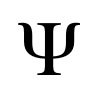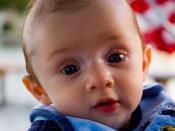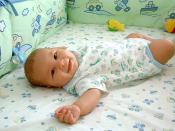The debate over whether or not infants are born with innate knowledge has been a long one. Nativist philosophers such as Kant (1781/1958) and Descartes (1638/1965) believed that certain abilities and understandings about the world were innate, whereas Empiricist William James (1890) believed, infants were a tabula rasa (blank slate) upon which information is "written". Even today the debate over whether or not infants are born with innate abilities has not been resolved, but by looking at research conducted into imitation with neonates Meltzoff and Moore (1977, 1983) and by considering possible functions of imitation is it possible to draw some conclusions. Similarly, it is not known whether or not infants recognise the human face innately or if it is knowledge acquired over time. Morton and Johnson suggest infants may be born with CONSPEC a mechanism which enables them to learn, and recognise their mothers by, external features.
Piaget (1951), considered the imitation of facial gestures to be a key developmental stage, which was reached at 8-12 months, and noted that it was a landmark achievement, as the imitation of facial expressions requires the human neonate to equate their own unseen behaviours with gestures they see performed by others.
More recent studies have disproved Piaget's belief that neonates lack perceptual-cognitive sophistication to perform imitative tasks until around the age 8-12 months and it is widely accepted that neonates imitate much early than he suggested.
Meltzoff and Moore (1977, 1983) have conducted much of the research involving imitation in neonates. They conducted several studies involving neonates of varying ages and their ability to imitate facial expressions. Their 1983 study involving 12-21 day old neonates showed that although all neonates could not imitate all facial expressions displayed, all but one neonate could imitate at least one. Given that the ability to imitate...



Very good
This is a very good essay with well balanced arguements and relevant research cited.
1 out of 2 people found this comment useful.